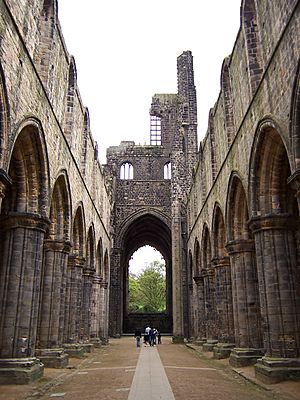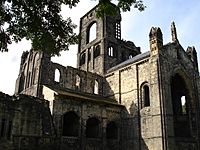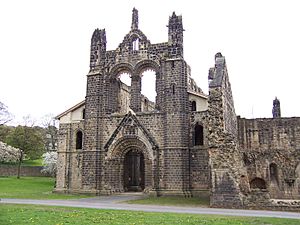Kirkstall Abbey facts for kids
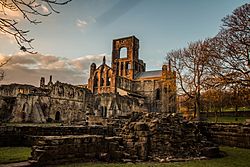 |
|
| Monastery information | |
|---|---|
| Order | Cistercian |
| Established | 1152 |
| Disestablished | 1538 |
| Mother house | Fountains Abbey |
| Diocese | Diocese of York |
| People | |
| Founder(s) | Abbot Alexander |
| Architecture | |
| Heritage designation | Grade I |
| Site | |
| Location | Kirkstall, Leeds, West Yorkshire, England |
| Coordinates | 53°49′16″N 1°36′24″W / 53.8210°N 1.6066°W |
| Grid reference | SE258361 |
| Visible remains | Substantial |
| Public access | Yes |
Kirkstall Abbey is a beautiful ruined Cistercian monastery located in Kirkstall, a part of Leeds in West Yorkshire, England. You can find it in a public park right next to the River Aire. This historic abbey was started around 1152. It was closed down in 1538 during a time called the Dissolution of the Monasteries by King Henry VIII.
Many famous artists, like J. M. W. Turner and Thomas Girtin, have drawn and painted these amazing ruins. Their artwork shows how special and picturesque the abbey has always been.
Later, Leeds City Council received Kirkstall Abbey as a gift from Colonel North. It was then opened for everyone to visit in the late 1800s. The old gatehouse of the abbey became a museum, which is now part of the Leeds Museums & Galleries family.
Contents
How Kirkstall Abbey Started
The story of Kirkstall Abbey began with a promise. A powerful lord named Henry de Lacy became very ill. He promised to build an abbey dedicated to the Virgin Mary if he got better. When he recovered, he kept his word!
Henry de Lacy offered land at Barnoldswick to the Abbot of Fountains Abbey. In May 1147, Abbot Alexander and twelve Cistercian monks from Fountains Abbey went to Barnoldswick. They tried to build their new abbey there. However, after six years, they found the place was not good for living.
Abbot Alexander then searched for a better spot. He discovered a lovely, wooded area in the Aire Valley where some hermits lived. Henry de Lacy helped the monks get this land from William de Poitou. The monks moved from Barnoldswick to Kirkstall in 1152. The hermits living there either joined the abbey or were paid to move. Most of the abbey buildings were finished between 1152 and 1182. The stone used for building came from Bramley Fall, across the river.
What the Buildings Looked Like
Cistercian abbeys in England, like Fountains, Rievaulx, and Kirkstall, often followed a similar building plan. Kirkstall Abbey is one of the best examples of this style.
The church itself was built in the Cistercian way. It had a short chancel (the area near the altar) and transepts (the arms of the cross-shaped church). Each transept had three small chapels. The building was quite simple, with plain windows and no fancy decorations. The main part of the church, called the nave, also had no triforium (a gallery above the arches).
The windows and doorways had round tops, but the arches supporting the ceilings were pointed. This shows early Gothic styles. Later, in the 1400s, the large east window was replaced with a smaller one. The tower above the middle of the church was made taller in the 1500s, just before the abbey closed.
Next to the church, on the south side, was the cloister. This was a peaceful, open courtyard where the monks could walk and meditate. On the east side of the cloister was the chapter house, where the monks met daily. Nearby were a small room for sacred items (sacristy) and a parlour for talking. Beyond these was the warming house, where monks could get warm. Above these rooms was the monks' dormitory, where they slept.
On the south side of the cloister, you can see the remains of the old dining hall, called the refectory. There was also a newer, larger refectory built later. Close to the dining areas were the kitchen and storage rooms. The western side of the cloister had vaulted cellars. Above these cellars was the dormitory for the lay brothers, who helped with the abbey's daily work.
The abbey also had other important buildings. There were walls and foundations of a group of buildings to the southeast. These might have been the guest house or the abbot's home. However, they are in the spot where the infirmary (a place for the sick) was usually found. There was a very large hall in this area. Between the monastery and the river were fish-ponds. The abbey also had a mill about 80 yards to the northwest, with a clear millpool and stream.
The Abbey's Later Story
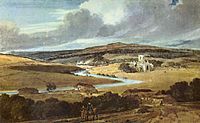
On November 22, 1539, Kirkstall Abbey was given to King Henry VIII's officials. This was part of the Dissolution of the Monasteries, when many religious houses were closed. The abbey was given to Thomas Cranmer in 1542. But it went back to the king when Cranmer was executed in 1556.
Sir Robert Savile bought the estate in 1584, and his family owned it for nearly a hundred years. In 1671, it passed to the Brudenell family. Much of the abbey's stone was taken and used to build other structures in the area. For example, some stones were used for the steps leading to the river bank by Leeds Bridge.
During the 1700s, the beautiful ruins became popular with artists of the Romantic movement. Painters like J. M. W. Turner, John Sell Cotman, and Thomas Girtin captured its charm. In 1889, Colonel John North bought the abbey and gave it to Leeds City Council. The Council worked hard to restore the abbey, and it opened to the public in 1895.
Some important archaeological digs happened in the 1950s. Experts from Leeds City Museums and Leeds University carefully explored the abbey. They helped us learn more about its history and how it was built.
Kirkstall Abbey Today

Today, Kirkstall Abbey is a very important historic site. It is a Grade I listed building and a scheduled ancient monument. After a big renovation project, there is now a new visitor centre. It has fun, interactive exhibits that show the abbey's history and what life was like for the monks. You enter the abbey through this visitor centre.
The abbey is surrounded by a large public park, covering about 23.5 hectares (58 acres). This park has lovely landscaped areas, open grassy fields, tennis courts, and a children's play area. You can also find rugby and football pitches there.
Across the main road, the old abbey gatehouse is now the Abbey House Museum. It's another great place to learn about the area's history.
Fun Events at the Abbey
The abbey grounds are often used for special events. The Leeds Shakespeare Festival used to perform plays in the cloisters every year. The park also hosts events like the annual Kirkstall Festival and open-air concerts.
In 2011, the abbey was a filming location for a live BBC Three show called Frankenstein's Wedding... Live in Leeds. It was a music drama starring Andrew Gower and Lacey Turner.
Also in 2011, the band Kaiser Chiefs played two big concerts at Kirkstall Abbey. Each concert had an audience of up to 10,000 people! The BBC Television series Gunpowder (2017) also used Kirkstall Abbey as a place to film.
See also
 In Spanish: Abadía de Kirkstall para niños
In Spanish: Abadía de Kirkstall para niños
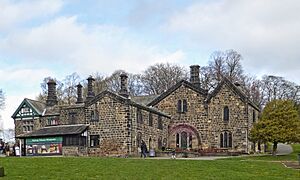
- Grade I listed buildings in West Yorkshire
- Listed buildings in Leeds (Kirkstall Ward)
- Abbey House Museum
- Architecture of Leeds



